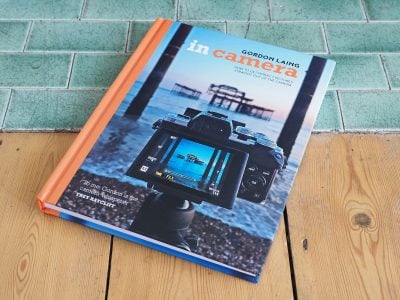Bear Photography at Brooks Falls
-
-
Written by Gordon Laing
Every year millions of Pacific Salmon return to the streams where they were born to spawn and die. Swimming against the current in their epic journey they must navigate rapids and leap waterfalls while avoiding the attention of hungry predators. It’s an annual bonanza for human and animal fishers alike, with one of nature’s most iconic views being Brown Bears intercepting leaping salmon in mid-flight.
Unlike many of Nature’s Great Events which are best viewed on TV though, this is one you can personally witness and photograph at close range at Brooks Falls in Alaska; indeed if you’ve ever seen a photo or footage of a bear fishing for salmon alongside a waterfall, chances are it was captured at this very spot. The drama of this event coupled with the sheer proximity of viewing made Brooks Falls one of the places I’d always wanted to visit, and in July 2010 I finally made it a reality.
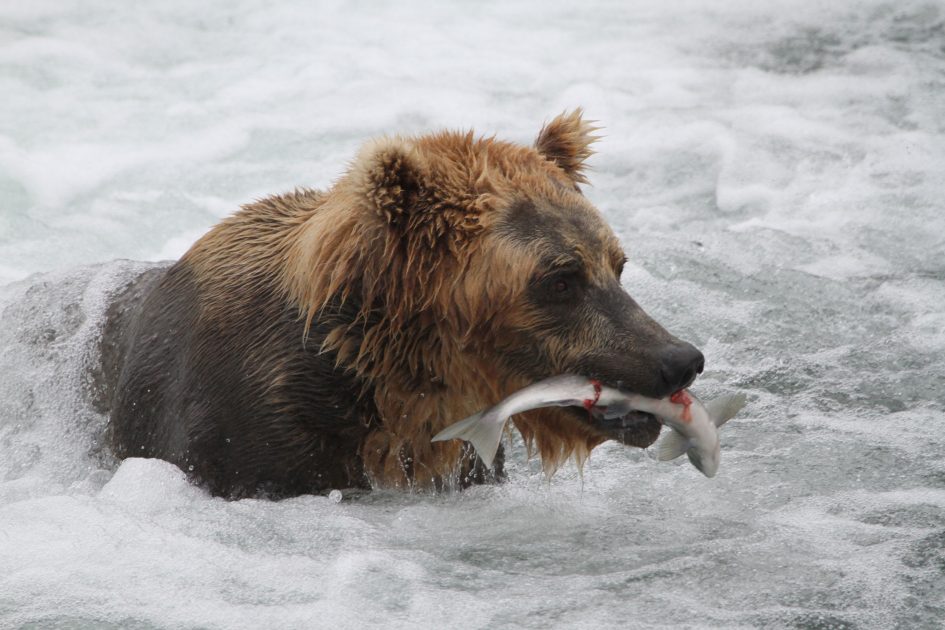
While the facilities at Brooks Falls place you right next to the action, the journey and cost to get there are not insignificant, especially if you’re based outside the US. As such like most visitors I did a great deal of research prior to the event to maximise my chances of success, but found surprisingly little technical information on photography not to mention what you can expect from typical tour operators.
For example, how long can you expect to spend at the falls? What sort of lens is best at this location? What should you take on board the flight and what’s best left at home? What happens when flights are delayed due to weather? So this article serves two purposes: first a review of the experience and operator itself for anyone organising a visit to Brooks, and secondly a technical look behind the equipment you’ll need to effectively capture this event.
Brooks Falls bear viewing with Katmailand
Brooks Falls is located just over a mile from Brooks Lodge, itself on the shore of Naknek Lake. The lake lies towards the Western side of Katmai National Park, which is about 300 miles South West of Anchorage in Alaska. There’s no roads to the camp, so the only way you’ll get there is by boat, or more commonly, float plane, landing on the lake. The peak time for bear viewing is at the height of the annual salmon run, which takes place during July. Exactly when in July is the gamble you’ll need to make when booking your trip.
The main hub serving Brooks Camp is King Salmon, a small town with an even smaller airport. If you’re starting your journey in Anchorage, you’ll typically change at King Salmon onto a float plane for the final leg which takes about 20-30 minutes. King Salmon is about 90 minute’s flight from Anchorage, so with a good connection and no delays, you could theoretically get from Anchorage to Brooks Camp in little over two hours.
Numerous operators offer flights in and out of King Salmon, with many offering packages from Anchorage (or other larger towns) which include both flights. I had a very small window of opportunity with just two days in Anchorage on 26 and 27 July, so booked a one day tour for the 26; I figured if it was cancelled due to bad weather, I’d at least have one day to try again.
I briefly contemplated booking scheduled flights to and from King Salmon and approaching an operator for the final leg to Brooks Camp, but fearing delays and missed connections, I opted for a package which included both flights. After checking a variety of operators I narrowed my choice to Rusts and Katmailand. The former uniquely flies a float plane direct from Anchorage to Brooks Camp without connections en-route, but admitted it was more subject to cancellations from weather as a result. I thanked them for their honesty and booked a Bear Viewing Day Trip with Katmailand instead which in 2010 cost $619 including all fees and taxes, although a small fuel surcharge may also be applicable (it wasn’t in my case). I made my initial enquiry at the end of April and booked it in mid-May.
Katmailand delivered good customer support by email, but annoyingly didn’t accept online payments with a credit or debit card. Instead you’ll need to either raise a US cheque or wire the money directly into their account. I opted for the latter and was informed there’d be an additional $45 fee to cover potential wire charges at their end, with any spare being refunded as a voucher valid at Brooks Camp for food or supplies. Knowing my bank would debit its fee directly, I ascertained the fee at Katmailand’s bank would be $10 so added that to the total instead. This proved fortuitous as delays would prevent me from spending anything at the camp on the day.
When booking, Katmailand quoted its one-day schedule as departing Anchorage at 7:45am, before changing planes in King Salmon and arriving at Brooks Lodge at approximately 10:30-11am. The plane would then depart Brooks Lodge at approximately 5-6pm, before changing again in King Salmon and arriving back at Anchorage at 8:40pm. Assuming no delays, this should give you six or seven hours at Brooks Lodge, providing ample bear viewing. Unfortunately this was not to be the case on the day I visited.
When booking, Katmailand said my travel documents would be emailed out four to five weeks prior to the reservation, but with no news by July 6 and just three weeks to go, I decided to contact them directly. I was subsequently informed my return flight would now be a little earlier than normal and that I was wait-listed on a later one. On July 15, I was told my flight out of Brooks would now be at approximately 3pm, or maybe a little later; the time would be determined out at Brooks itself on the day. I was understandably disappointed to discover two to three hours had been cut from my day at Brooks without explanation, but I’d since learnt the flight times out of the camp could be quite fluid and besides, I’d still have at least three hours there. Or at least I thought I would.
Brooks Falls on the day
Like many Brooks Falls operators, Katmailand has a small reception and hanger on the edge of Lake Hood at Anchorage airport, and this is where you check-in as oppose to the main airport terminal. As instructed I checked-in at 6:45am one hour prior to departure and met the other five people booked on the same day trip. The staff were friendly, but sadly the weather wasn’t playing ball, with rain in Anchorage and more importantly, fog at our destination causing delays – so we settled-down in the small reception and starting working our way through the various nature DVDs on the TV. Coffee, water and unappetising long-life pastries were provided, but we weren’t allowed to venture further afield in case we needed to board the plane quickly.
One hour passed, then two, then three. The pilot gave us regular updates, but I had a sinking feeling as my already truncated trip grew steadily shorter. I explained to the staff I had a spare day tomorrow and could reschedule if necessary, while other members in my group asked at what point the trip would be aborted. But the staff replied they’d do everything they could to get us out on this day and there was no need to talk about cancellations yet. At the time I took this as being a positive attitude, but later felt it was more a case of simply fulfilling their contract of flying us to and from Brooks with little thought for the actual experience or time spent at the camp itself.
To be fair, most flight packages to Brooks Camp are non-refundable if cancelled by bad weather, so Katmailand’s continued efforts to get us out there on the day were appreciated. But equally I had confirmed by email earlier that if the trip was to be cancelled by weather, I could reschedule for a later date at no extra charge. As the time passed and my window of potential bear viewing grew ever smaller, I wanted to reschedule, but again the staff were 100% focused on getting us all out on the day we had booked. Once again I began to feel this was more to fulfil and clear today’s bookings in order to start tomorrow afresh.
It’s also worth noting that most flight packages to Brooks are just that: flights there and back, leaving the guest to self-guide at the destination. As an independent traveller, I much prefer this to guided tours, but equally it means there’s no specific mention of wildlife viewing or minimum times at the Camp. The operator has fulfilled their requirement by simply getting you there and back, even if you’re only there for a very brief period.

After waiting in Katmailand’s reception for four hours, the pilot returned, confident we could now make it, via King Salmon, as opposed to the originally-planned connection at Kulik Lodge. So we quickly boarded the seven seater plane (nine including pilot and co-pilot seats), and finally departed Anchorage shortly after 11am. Two hours later we landed on water at King Salmon and met a number of other delayed travellers at the Katmailand hut. Keen to get us moving we were quickly assigned connections, with our group of six joining one other on a slightly larger float plane; I expressed my concern about having to return on a flight at 3pm and was told I should speak to the office at Brooks Camp. Within half an hour of landing at King Salmon we were in the air again, before finally touching down at our final destination of Naknek lake at about 1:50pm. The rain had stopped and the cloud lifted; it wasn’t sunny by any means, but it was dry and the earlier precipitation had reduced the number of biting insects.
Any worries about not seeing bears were also wiped-out as soon as the plane approached the beach to meet a mother with four cubs casually strolling past. It was a fantastic view, albeit one which prevented us from getting off the plane until they’d passed to a safe distance ten minutes later. We had a great view through the open plane door though and I managed to fire-off a number of shots and a few minutes of video. I’d fortuitously kept my DSLR with me on the flight, although annoyingly my long lens and camcorder were out-of-reach in the hold just behind the seats, leaving me with a general-purpose zoom; note to self, keep the big lens with you at all times on trips like these.

At 2pm we disembarked the plane and attended the compulsory bear etiquette briefing by the park rangers. At 2:15pm I ran to the office to find out what could be done about my return flight, which was due to leave in just 45 minutes time. This would have meant no chance of any bear viewing at the falls.
I spoke with a very stern man who stated I would need to leave at 3pm in order to make my 6pm connection at King Salmon back to Anchorage, and that all other flights were fully booked. I replied I’d never requested those times and originally booked a trip which wasn’t scheduled to leave Brooks until 5 or 6pm. I also stated I’d made it clear I could reschedule for tomorrow, but the staff insisted we flew today. He replied that was because they were fully booked the next day, but I countered we’d overheard the Anchorage office take booking enquiries for the next day as we waited in reception.
Throughout our conversation he fixed me with an intimidating steely look not unlike the ones Lance Armstrong gave to rivals as he passed them on the mountain stages of The Tour de France. He clearly wasn’t happy with the situation and I almost felt unreasonable expecting more than 45 minutes at the camp. I explained I understood there could be delays and cancellations due to weather, but that there should be a minimum acceptable time at the camp beyond which a reschedule should be offered.
After a little more hard staring he said he’d make a call to see what could be done. He returned a few moments later to say he could change me onto the 5pm flight with a possibility of the 6pm plane, but that’d I’d subsequently miss my connection at King Salmon back to Anchorage and would have to wait until 11pm for the next one. I was expected back in Anchorage around 8pm, but realised this was my only chance to see the bears, so accepted it gratefully. The office agreed to get a message to my group in Anchorage and told me I’d need to be back at the beach by 4:30pm; it was now around 2:30pm and I’d not eaten since 6am. Lunch was being served at the Lodge cafeteria, but the only thing on my mind was getting to the falls.
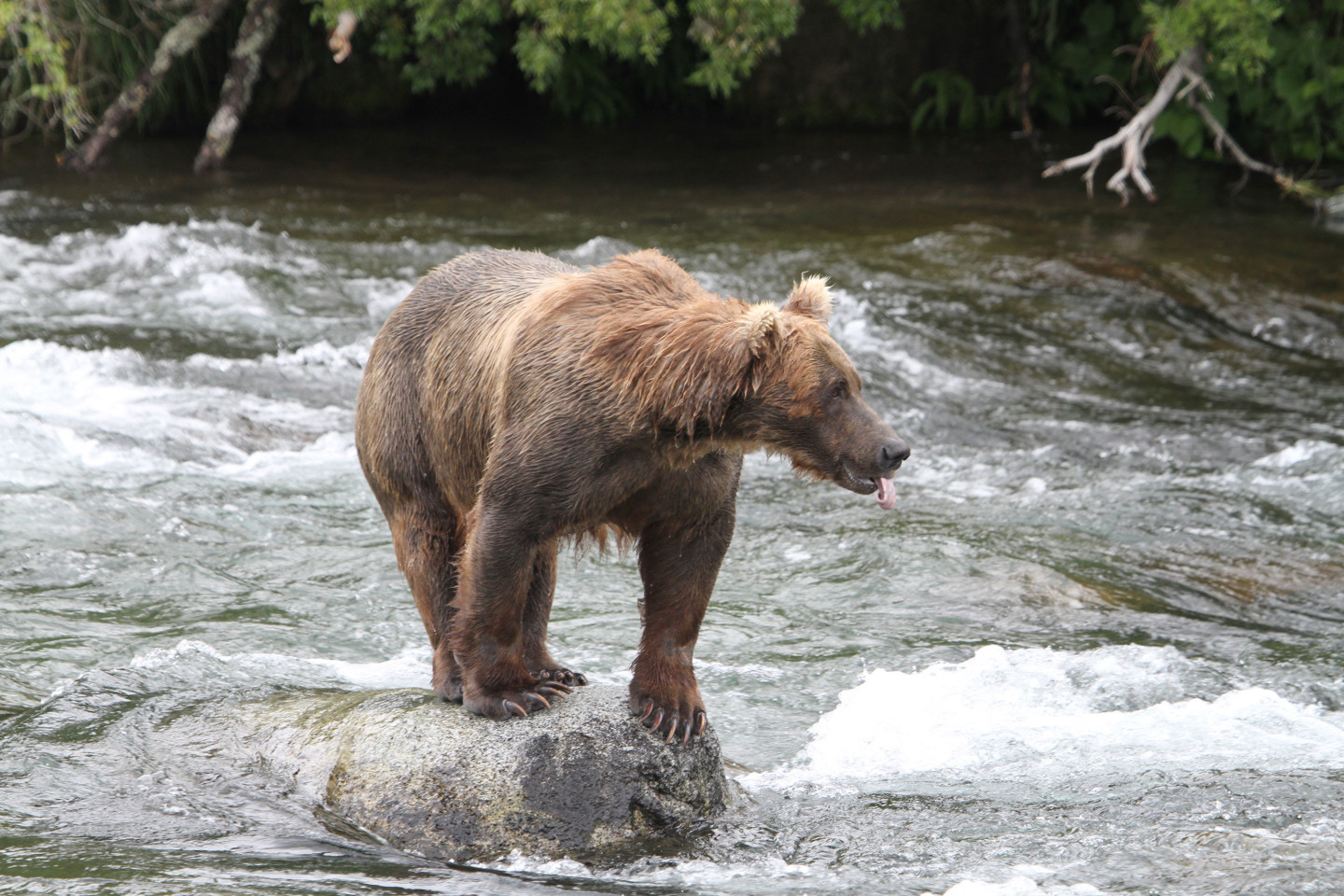
Brooks Falls is located 1.2 miles from the camp visitor centre along a well-defined walking track, which at times becomes a dirt-track road. It’s pretty flat, although a little boggy at times if there’s been rain. Bears can be seen on the track and the park ranger’s briefing states 50 yards must be kept between you and them at all times, or 100 yards if it’s a mother with cubs. While you walk along the track, you should make plenty of noise, regularly shouting ‘hey bear’ to ensure they know you’re coming. This particularly applies to anyone walking the track by themselves as I found myself doing.
Bears are known to settle on the track at which point you’re effectively stuck and unable to pass until they decide to move. Fortunately that wasn’t the case on my quick walk to the falls, although as it was peak viewing time I was up against a human traffic jam instead. The closest viewing platform to the falls and the bears can accommodate 40 people and when it’s full, the park rangers operate a time limit of one hour per person. Those waiting for a position can still view the falls from a lower platform though. Upon ‘check-in’ with the rangers I explained my flight was leaving in less than two hours and they said they’d see what they could do. About five minutes later they came to get me on the lower platform and told me I could move onto the upper one. I should say I was very impressed with all the rangers I dealt with on the day – all were very friendly, helpful and accommodating.
I reached the upper falls platform at about 3:15pm and was told I’d have one hour there. No problem as I needed to leave at 4:15pm in order to make it back to the beach for 4:30pm as promised. The platform itself is on two levels, but the front row of each were completely jammed with people, with no room to peek overhead, let alone set up a tripod. I was initially dismayed, but the constant refreshing of people after their one hour slots means gaps regularly open up. Within a few moments of arriving, I had a prime spot on the lower of the two platforms and sufficient room to set up my small tripod.
There were six bears fishing on the falls, with several more in the river and I didn’t have to wait long for some action. Literally seconds after pointing my camera at one of the closest bears atop the waterfall, he caught a fish; admittedly not the money shot of one flying through the air, but a catch none-the-less. This bear proved to be the most proficient fisher of the group, catching another just a few minutes later, and no fewer than six during my hour there.
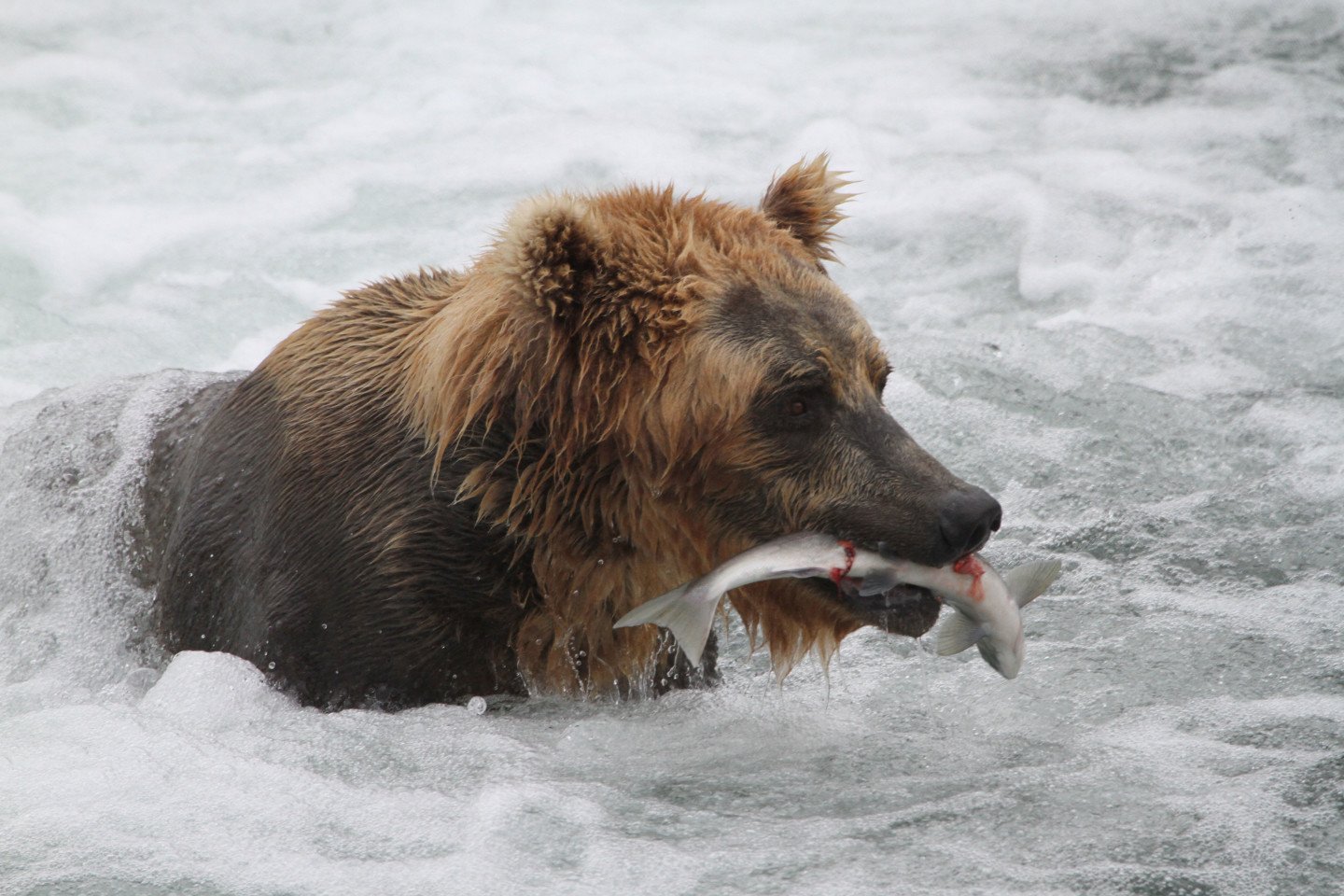
I’m fairly inexperienced when it comes to wildlife photography, but found a technique which proved quite successful on the day. First, pick a bear. Second, compose your shot and make sure it’s in focus; thankfully the bears tend to stay perfectly still when fishing, allowing you to easily check and confirm your settings. Next, unless you want a shot with blurred motion, ensure your shutter speed is sufficiently quick to freeze the action. I found shutter speeds around 1/1000 were essential to capture the quickest action and on the day with the lens in question, that meant using sensitivities of 400-800 ISO. Finally make sure your camera is set to its fastest continuous shooting mode, then wait with your finger poised on the shutter (or cable) release. As a side-note, I found continuous AF to be unreliable with these subjects, so stuck with single AF modes instead.
While you could handhold your shots, I’d strongly recommend using a tripod. This allows you to not only take the weight of a potentially heavy lens over long periods, but means you can also leave the camera aimed precisely at the subject and ready for action. I actually rarely looked through the viewfinder on the day, instead preferring to monitor the entire falls with my eyes, but never taking my finger from the release. Then when I saw the bear make its move, I pressed down on the shutter release, fired-off a load of frames and kept my fingers crossed I’d captured the moment.
More often than not I’d miss the initial split-second catch and grab, but I did manage to capture it a couple of times including one occasion where a fish leapt through the air and actually bounced off the bear’s nose – that’s the shot you’ll see at the top of the first and third pages on this article.
If you’re into wildlife photography, you’ll know there are no guarantees. You could spend hours, days or even weeks attempting to capture your subject and even then have no success. At Brooks Falls I got the leaping salmon shot I came for after just ten minutes, then was lucky enough to capture it again on video only a few minutes later. I found myself in the slightly unnerving position of accomplishing everything I’d come for within a quarter of an hour. I’d been unlucky with the delays, but it had all come together at this point and I was delighted. I spent the remaining 45 minutes taking more stills and video with a more casual approach, and just enjoying the bears with my eyes. It was fantastic.
Back to the beach
At 4:15pm I left for the beach, although by that time a number of people had also left the platform, allowing those with later flights to stick around for more than their allotted hour. While my walk to the falls had been uneventful though, I was met with a bear on the track just a few meters beyond the wooden platform structure. It was coming round a corner and considerably less than 50 yards away, stopping to stare at me. I’m not ashamed to admit this was the most frightening thing I’ve ever experienced. Watching bears from the safety of a raised platform with 40 people and a number of rangers is completely different to coming across one at close range by yourself with nothing between you and it. Yelling ‘hey bear’ had no effect so as recommended, I informed the bear of my intentions and slowly backed off to the start of the wooden track. The bear nonchalantly turned and wandered into the forest.
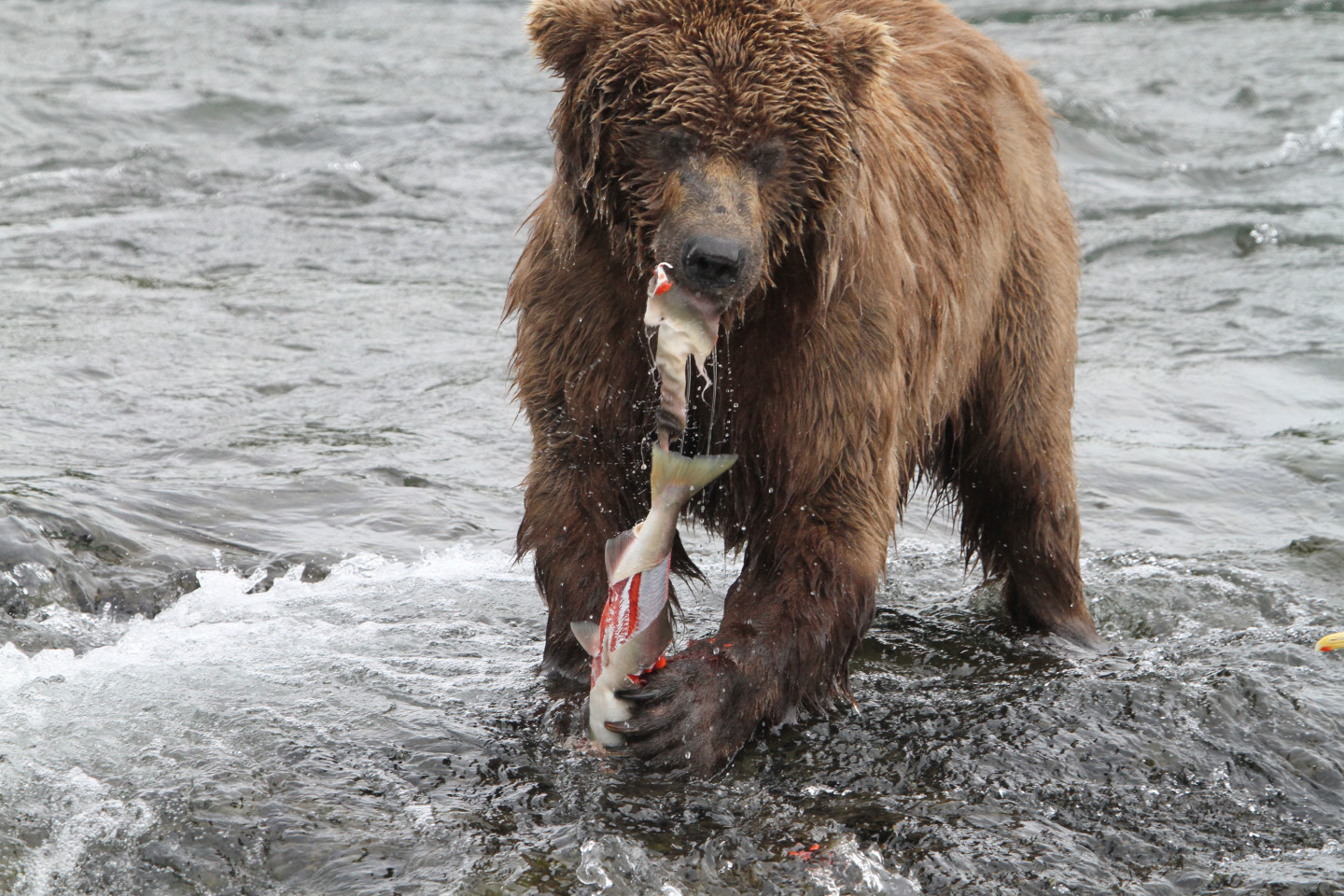
Aware I was running out of time to get back to the beach for my 5pm flight, I marched back along the path, only to come across another bear around the next corner. This was becoming truly unnerving, although again this one wandered off without incident. Believe it or not, I was met by no fewer than five bears on the one mile track between the falls and the beach and by the time I checked-in at the office my heart was racing. My old pal Mr Stern greeted me with another hard look and told me I was now on the later 6pm flight, but that I should stick around the camp area rather than return to the falls. As luck would have it, the mother and cubs we’d seen earlier were at one end of the beach, giving those waiting for planes a good view.
At this point it was around 5pm and my stomach reminded me it had not received any food for 11 hours. The Lodge dinner buffet wasn’t served until 5:30pm but when I asked if I’d have time to grab a quick bite, Mr Stern stated I could not. So I sloped off to the small store for a handful of museli bars which the rangers let me eat on the beach. I spent my last three quarters of an hour on the beach viewing the mother and cubs from a distance, munching museli bars, watching float planes gradually ferry people home and chatting with the Alpha Males of the photography world who’d come equipped with 800mm lenses.
Towards 6pm I moved closer to the parked float planes to wait for mine and filmed some more video. As I filmed one plane land, Mr Stern walked right in front of my camera despite there being plenty of room to go behind. I didn’t react but got the impression I’d really put him out by requesting a later flight. In his defence he did arrange everything I asked for and I later discovered my message had got through to my group in Anchorage. Since I’d also got a good look at the bears fishing, my mission was well and truly accomplished, but he left me with a bad feeling like I had been the unreasonable one. Maybe he was just representative of a tough Alaskan dealing with unhappy customers and limited options. Maybe my feeling was simply down to built-in British guilt complex. Either way, that’s how it felt, and his attitude was in stark contrast to everyone else I met there who were all very friendly.
Ultimately though no amount of (perceived) conflict nor lack of food could dampen my enthusiasm for the day as it turned out. It was a real adventure and I managed to get exactly what I came for. It was worth it even for just one hour at the falls during the salmon run. Brooks Falls really delivered the goods and I’d highly recommend it for anyone wanting to view and photograph bears fishing at close range.
My seven-seater plane lifted off from Naknek lake at 6:20pm and landed at King Salmon 22 minutes later. We were bussed to the main terminal which was packed with people waiting for flights, so there was no chance of getting anything earlier than my rescheduled departure time of 11pm. Which only leaves the question of what to do at King Salmon airport for four hours?
While Seinfeld repeats on the TV beckoned, I couldn’t help but hear loud country music coming from the large hanger next door. I popped my head round to discover a promotional event for a gentleman hoping to become Alaska’s next Governor. The people on the door took pity and let me in to enjoy the party. A couple of hotdogs – served by the Senator no less – along with a pair of Alaskan Amber ales later and the delay didn’t seem so much of a problem. I’d like to thank them all for their hospitality and a meal which tasted absolutely divine after the lack of food during the day. I finally landed back at Anchorage around 1am.
What I learnt and what I’d do next time
The most important lesson I learnt during my day getting to and from Brooks Falls was to forget any concept of schedule. Alaska’s frequently poor and unpredictable weather means delays are common and there’s a good chance your timing and even route will be different to that originally planned. As I discovered, the camp office are able to accommodate some changes even at the busiest times, but be prepared to accept long waits (and hard stares). The bottom line is they will get you home, but don’t make plans for that evening. So just relax and go with the flow.
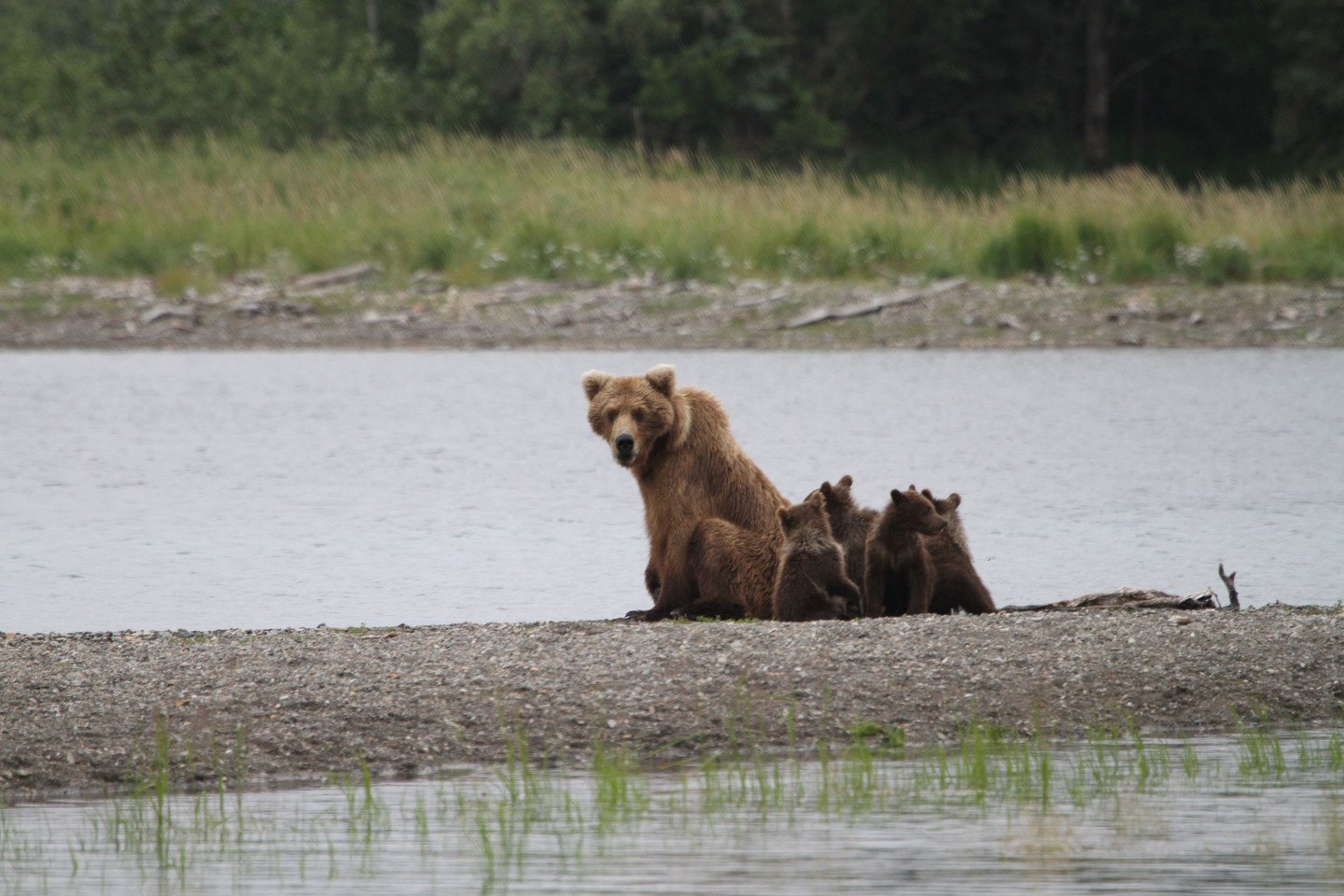
The second lesson I learnt was a flights-only package doesn’t make any guarantee for actual time spent at the destination. Ambiguous wording on the initial schedule and flight changes after booking, not to mention unpredictable weather means you could, like me, spend much less time at the falls than you expected. The only goal for the package operator is to get you there and back safely on the day, which, to be fair, they did.
I don’t believe a stricter approach to booking or negotiating would have made any difference either. Weather delayed our departure. Over-bookings resulted in an earlier than expected return. Cancellations are non-refundable. That’s life if you want to visit Brooks Falls. It’s not like a whale watching trip where many operators actually offer your money back if there aren’t any sightings. By the end of the day I got the impression any schedule was simply an impression of what might happen under ideal circumstances. Even when assured of a connection, you may not make it.
For instance, the five other members of my initial group had all booked much earlier than I had, and were confirmed on a 6pm float plane out of Brooks and a 7pm (ish) flight from King Salmon to Anchorage. Four were boarded on one float plane which left just after 6pm, leaving the fifth to squeeze onto my float plane which left about ten minutes later. The first four made it back in time for their 7pm connection, but upon check-in the fifth was told he’d arrived a few minutes too late. He too now had to wait for the 11pm flight although unlike this shameless gatecrasher, gave the wannabe Governor’s party a miss.
That said, I would definitely advise anyone on a day trip to discuss minimum times at the destination with their operator. Weather delays are understandable and if you only have one day, then you’re stuck, but if there’s a possibility of rescheduling for a later date then there should be a cut-off point when it’s just not worth departing Anchorage. I strongly believe Katmailand should not have put me on an 11am flight from Anchorage knowing I’d only have one hour at Brooks Camp (and no chance to view the falls) before returning on a 3pm flight. Maybe I was expected to put my case to Mr Stern and argue for a later departure. I think I should have been given the option to reschedule since I’d made it clear I’d kept the following day free. And while we’re at it, any business which could keep you in a room for four hours without the chance of leaving needs to have better food and drink options.
The third lesson learnt was to give yourself more than one chance to see the bears. Now I thought I’d already done that, by keeping the next day free in Anchorage in case I needed to reschedule at the last minute. But as I discovered, my flight operator was keen to clear its day of bookings even if it meant leaving one of their passengers with just 45 minutes at the destination and no chance of getting to the falls. Rescheduling following weather delays was not presented as an option even though it had previously been discussed by email.
So I’d recommend keeping two or more days free but spending them all at the camp. If you don’t have a flight to catch back on the same day, you’ll be much more relaxed about arriving late or being delayed for whatever reason. It’ll also be much quieter at the viewing area after 4:30pm once the day-trippers have gone home. Just make sure you book your campsite (or if you’re feeling wealthy, the lodge) way in advance as places fill up fast. Sadly an overnight stay wasn’t possible for me on this trip, but next time I’d definitely stay for at least one night.
So the overall morals of this story are to stay for at least one night and forget about sticking to a set schedule. If you can only manage a day trip, be sure to ask your operator about minimum times spent at the destination, especially if you have another day free. And finally, try and keep Mr Stern on your side – he may give Paddington Bear a run for his money in the hard stares department, but he’s the guy who can make or break your visit.
Now onto the actual photographic side of things: what equipment do you need to photograph bears at Brooks Falls and how did my choices work out in the field?
Photographing bears at Brooks Falls – what I used
My primary goal at Brooks Falls was to see a bear catching a salmon in mid-leap. It’s a sight I’ve seen many times on the TV and in print, and I really wanted to try and capture it myself as a still photo, and if possible, on video too. Since I was travelling light though, I had to think carefully about what equipment to bring. While I could accommodate an additional small camcorder, the primary stills and video work would need to be done with a single camera.
My requirements for this camera were quick continuous shooting (above 5fps), 1080p video and some degree of weather-proofing to combat the Alaskan drizzle. At the time of writing, there were really only two choices, and both were from Canon: the EOS 1D Mark IV and the EOS 7D; note despite boasting the best image quality in the Canon range at the time of writing, the EOS 5D Mark II was ruled-out due to its modest continuous shooting speed, and while Nikon’s D300s did offer the build and speed I required, it lacked 1080p video.
The EOS 1D Mark IV would have been perfect for the job with 10fps continuous shooting, tough build and 1080p video, but it was too expensive and I also wanted to travel as light as possible. Consequently the EOS 7D became my number one choice, while also being physically easier to handle for video. Many thanks to Canon New Zealand, which loaned me a 7D for the duration of my trip. See my Canon EOS 7D review for full details.
I had room for two lenses, a general-purpose zoom, and a longer model for the wildlife close-ups. The first was an easy choice: in my view Canon’s EF-S 15-85mm IS USM is the best all-round general-purpose zoom for its range of cropped-frame bodies and my number one recommendation unless a brighter aperture is required (in which case go for the EF-S 17-55mm f2.8). See my Canon EF-S 15-85mm IS USM review for more details.
The telephoto was a slightly tougher decision. The variation in distances meant a zoom was necessary, and I toyed with the idea of one of Sigma’s many options. But with the 100-400mm range being ideal for the distances at Brooks Falls and weather-proofing a big plus, Canon’s EF 100-400mm f4.5-5.6L IS USM perfectly fitted the bill. Sure it’s an ageing model with first-generation stabilisation which can’t compete with the latest lenses, but it remains a strong choice for close-range wildlife photographers.
Canon New Zealand was generous enough to loan me the EF-S 15-85mm, but unable to supply the telephoto zoom, so I rented one instead from Borrow Lenses in California. They delivered to a friend I was meeting in the US prior to the Brooks Falls trip and allowed me to drop it off at the downtown Anchorage FedEx office. This actually worked out really well as I wasn’t lugging around a big heavy lens during other portions of my longer trip where it was unnecessary; instead I just rented it for the period I needed. It’s a great idea for trips and special events, or to simply trial a new lens before buying.
The EOS 7D with EF 100-400mm lens may be fairly compact in serious wildlife photography terms, but I still didn’t relish the idea of handholding it for my time at Brooks Falls. A tripod with a fast-acting ball head was the answer, but again it had to be relatively small and light.
As anyone who’s searched for the perfect travel tripod knows, some compromise is necessary. You can buy small and light tripods, but they’re rarely very sturdy. You can buy sturdy tripods, but they’re rarely that portable. I know, I’ve been through countless models. I’ve taken tiny tripods away only to be frustrated with their stability and height. I’ve lugged full-sized models and loved their height and rigidity, but hated their size and weight. I’ve also spent a while trying to convince myself the Gorillapod was the answer, but frequently found myself without anything to wrap its legs around. Is there really a perfect travel tripod? One that’s sufficiently small and light to be portable, without compromising stability? I’m pleased to report there is, but you’d better have deep pockets.
The Gitzo 1541T is widely regarded by high-end tripod-philes as the ultimate travel pod. It’s not the smallest tripod around, but it is sufficiently portable for most trips, especially with the neat trick of folding its legs back on itself with the right head. The carbon fiber construction is light, without compromising Gitzo’s legendary build quality, while stability is as good as many considerably larger tripods. The downside? It costs more than a budget DSLR, and once you add a head with a plate system to do it justice, you’re approaching a grand in US dollars.
Arguably the best head for the 1541T is Markins’ Q-Ball Q3 Traveller, a compact ball and socket model designed to accommodate the tripod’s reverse-folding leg system. It’s small and light, but like the 1541T is superbly built. It’s also able to handle surprisingly hefty loads and was happy to accommodate the EOS 7D with EF 100-400mm lens.
I took a gamble with both the tripod and head as neither company was able to supply a loan for review. Markins inability to provide samples was understandable given the size of the company, although Gitzo’s was just down to being uncooperative. That said, the sheer number of positive comments about the 1541T and Q3T combination persuaded me it was an important pair of products to test, so I took a deep breath and purchased both. I plan to review them in the near future, and hopefully use them for the rest of my life. PS – a quick note to the highest-end tripod fanatics: rather than fit a quick release system from another company such as Really Right Stuff, I went for Markins’ own plate system.
Equipment field report – how did it work in practice?
I’ll cut to the chase right now: while my trip to Brooks Falls involved many hurdles, the equipment I took performed flawlessly, and to be honest there’s little if anything I’d change for a future visit.
I was very impressed with the EOS 7D in my original review and it continued to deliver the goods in the field with its tough build and quick handling. It happily shrugged-off light drizzle during my travels through Alaska and was always ready to fire-off quick bursts when required. It may not be as rugged as the EOS 1D Mark IV, but this is as close as you’ll get to truly professional handling for the money.
I’d debated whether to take the EOS 5D Mark II instead, but when it came to photographing the bears in action I was pleased I’d gone for the EOS 7D. When a salmon jumps past a bear it’s literally swimming for its life and not hanging around – the event is over in a split second, so if you want more than a couple of frames showing it, you’ll need a camera with at least 5fps. My luckiest break came when a salmon leapt out the water and actually struck a bear on its nose before bouncing back. I managed to grab three shots with the salmon in the frame at 8fps. Shooting at less than half the speed, the EOS 5D Mark II would have only come away with one or two shots.
The EOS 7D continued to impress throughout my trip, confidently handling any situation. I should however note I switched to spot focusing for many of my shots as the various multi-point AF options tended to prioritise the closest areas which weren’t always what I wanted in focus – for example brims on hats or noses on bears. Switching to spot focusing allowed me to ensure eyes were in focus instead.
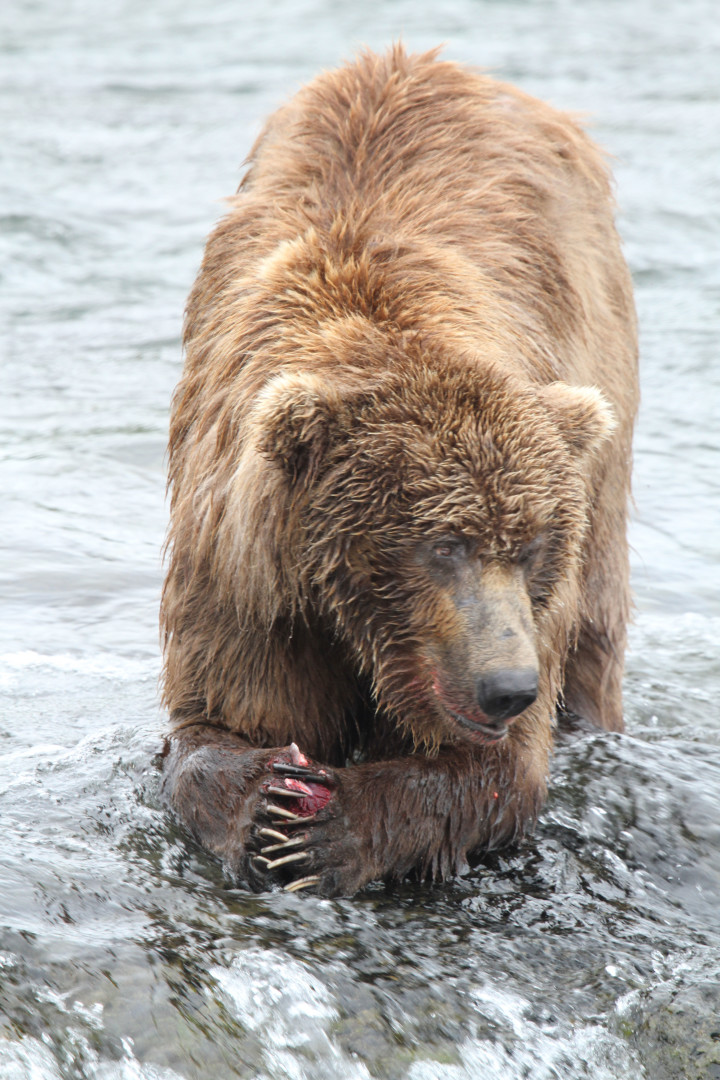
As for lenses I was delighted with both choices. In my Canon EF-S 15-85mm IS USM review I found it to be an excellent performer, and the few optical issues it suffered from were generally corrected at apertures around f8. It proved to be an excellent general-purpose lens and I wouldn’t hesitate to recommend it to owners of cropped-frame Canon bodies. The only aspect where it falls down is the lack of lens hood supplied as standard. Sadly Canon New Zealand was unable to supply a hood with the lens and there was no time to buy one, so I went hoodless. Annoyingly many of my photos and video sequences suffered from the lack of a hood, whether it was flare from the Sun or protection from drizzle. I’d strongly recommend buying the hood for this model.
The Canon EF 100-400mm IS USM on a cropped body proved to be the ideal wildlife lens for relatively close-range subjects. From the upper falls platform at Brooks, most of my bear shots were taken between 200 and 300mm, making a 70-300mm equally suitable, but it was nice to have the extra reach to 400mm for more distant bears or close-ups. I’d previously used this lens on a safari in Kenya and found it to be one of the most flexible choices there too. It’d be nice to have an updated version with the latest four-stop stabilisation system for handheld work, but once mounted on a tripod this becomes a non-issue. Did I yearn for a fast super-telephoto lens? Maybe for a couple of shots where bears were positioned at precisely the right distance, but to be honest the 100-400mm zoom range was unbeatable from the falls platform. Note: you’ll see all the shots here with the 100-400mm were taken at f6.3. I selected this aperture to avoid using the lens with its aperture wide-open to maximise quality and be a little more forgiving on focusing.
Which now brings us to the Gitzo 1541T tripod and Markins Q3T head. Putting aside Gitzo’s reluctance to work with me as a journalist and product tester, I fell for the tripod from the first moment I took it from the box. The build quality is quite simply superb with every part fitting together perfectly. Despite previously not getting on with twist-lock tripod legs, I became accustomed to the 1541T in moments: in a single grip and twist you can unlock an entire leg in one go, allowing you to extend and setup very quickly.
The reverse-folding leg system also works really well, shaving precious inches from the overall length of the tripod for transportation. Obviously this requires a compatible head (unless you want to remove it each time you pack away), and the Markins Q3T proved to be another superbly built piece of kit.
Having had some average to poor experiences with ball heads in the past I’d steered clear of them for a while, but the Markins Q3T is a revelation in use – incredibly smooth, able to handle surprisingly large weights and ideal for quick recompositions. The tripod and head combination worked so well in the field I had to keep reminding myself both represented the compact models in their respective ranges designed for modest loads.
Certainly if I’d taken the 1D Mark IV and fitted it with a 300mm f2.8 then I’d have wanted something much heftier, but the 1541T and Q3T proved surprisingly confident supporting the 7D with 100-400mm. Admittedly there was a little vibration visible on some video shot at the maximum focal lengths, but this was more down to movement on the platform than instability on the support. Of course if you demand absolute rock-solid performance with a big lens, then you’ll have to lug around a bigger support system, but for its size and weight, the 1541T with Q3T is very impressive. I look forward to writing a detailed report on both products in the near future.
Speaking of video, I filmed a number of sequences between stills using the EOS 7D, along with my own Canon HV30 camcorder; out of curiosity (not to mention security), I filmed several duplicate shots with both cameras, which also allowed me to compare the quality and experience of each system.
As anyone who’s filmed with a DSLR knows, there are pros and cons to the technology. The pros include a large sensor and access to a wide variety of lenses, while the major con is tricky handling compared to a camcorder, particularly when it comes to adjusting focus or focal length during a shot. During my time in Alaska, I decided to play to the strengths of both cameras, using the DSLR for wide, long, dark or generally static shots, and the camcorder for zooms or subjects which changed distance during the shot. I matched the frame rate of the 7D to my US-originated HV30 to allow better integration of clips in the same project: 30fps (29.97 actual).
I’ve assembled a short series of clips below, including a few at each end taken with the Canon IXUS 200 IS / SD980 IS compact to set the scene; the latter shot at 720p. It’s interesting to compare the quality and perspective of similar shots taken with the DSLR and camcorder. All the audio you hear was also captured by the respective cameras without any external microphones or post-processing.
The mostly static bears at Brooks Falls responded well to DSLR videography, and it was only when a successful catch saw the bear wander significantly away that there were any issues with the focus. But I was pleased to also have the camcorder with me for motorised zooms, not to mention as a backup for when I was taking stills with the DSLR. After capturing the catch and grab you’ll see in the video with the camcorder zoomed-in, I zoomed it back out again and left it on the ledge to monitor the entire falls while I shot stills with the EOS 7D; I’ve included some of this footage in the video above, where you can hear me shoot a burst with the EOS 7D as the bear at the top of the falls makes another catch. You can see the camcorder on the ledge in the photo below left.
Ultimately the products I bought, borrowed and rented worked perfectly for the environment and conditions, and unusually for wildlife photography, I didn’t yearn for anything bigger, longer or faster. Equally unusually given its world class location was the absence of higher-end kit at the falls. I’d fully expected to be wedged on the viewing platform between 600mm f4 lenses mounted on pro bodies, but was surprised to find myself as the alpha camera male on the platform in terms of kit – at least for the 60 minutes I was there anyway.
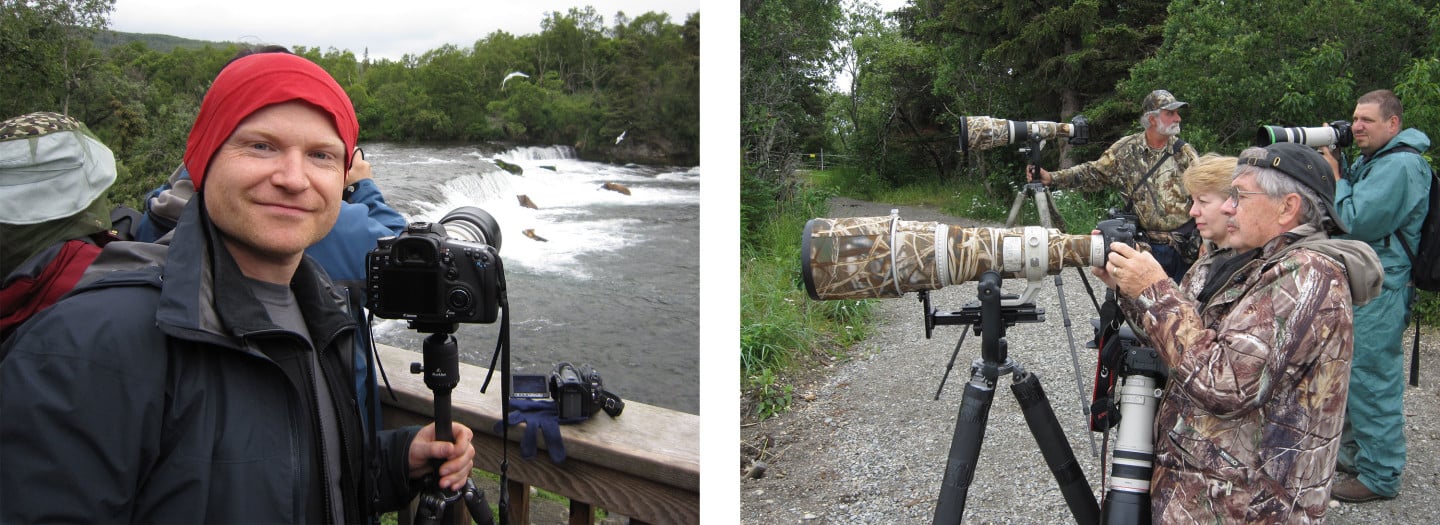
Upon arrival back at the beach though, I discovered where the real top dogs had been hanging out: two guys equipped with camouflaged Canon 800mm lenses and 1.4x teleconverters photographing a distant mother with four cubs (indeed the same family which delayed my arrival earlier).
As I recall, one was shooting with an EOS 7D and the other with one of the 1D range, but both had their setups supported on Wimberley heads directly mounted on large Gitzo tripods with the centre column removed for stability. This is pretty serious kit but both were happy for a chat, and one proudly explained how his 800mm had survived a recent dunk. Reassuringly for my own choice of equipment, both also carried backup bodies fitted with what looked like 100-400mm zooms.
While it’s impossible not to be envious of such setups though, those big guns would have been way too long at the falls. Ideal for the distant beach shots at this point, but not for the salmon shots I was after unless you wanted a very tight crop or were aiming at one of the furthest animals. I think this realisation further enhanced my view of Brooks Falls as not only did the platform place you right next to the action, but you could capture it with fairly modest equipment – at least in wildlife photography terms. Even those alongside me on the falls platform with compact cameras were grabbing decent shots.
Brooks Falls has the reputation as the best place to view bears fishing and it more than lived up to expectations. It’s not cheap to visit and your journey could be plagued with delays, but I can’t think of anywhere else which brings you this close to witnessing one of Nature’s Great Events.
Recommended equipment for photographing bears at Brooks Falls
DSLR with fast continuous shooting, ideally 5fps or quicker. Weather-proofing a bonus. Semi-pro models ideal.
Telephoto zoom lens around the 100-400mm range. 70-300mm also suitable. Longer focal lengths not required at falls platform, but useful around camp for distant or smaller subjects. See my Canon, Nikon and Sony telephoto lens guides, and don’t forget you don’t have to buy a big expensive lens just for one trip – depending on where you live, you could rent one from places like Borrow Lenses or Hireacamera.
Tripod to hold camera and lens in position on falls platform. Smaller models better-suited for squeezing between people. Ball and socket heads recommended for quick readjustments.
Backup / secondary camera. Camcorder useful for recording falls while you concentrate on stills. Could use Gorillapod or similar to mount on platform ledge with minimal impact on space.
One final tip: there’s virtually no room for hand luggage on the tiny float planes, but you should still try and carry your main camera and big lens by hand if possible. Not only are there great views from the air, but you may also have the chance to grab a few shots of bears on the beach upon arrival. If one strolling past is preventing your disembarkation, you don’t want to miss the chance to photograph it!
Check prices at Amazon, B&H, Adorama, eBay or Wex. Alternatively get yourself a copy of my In Camera book, an official Cameralabs T-shirt or mug, or treat me to a coffee! Thanks!
